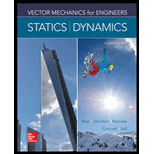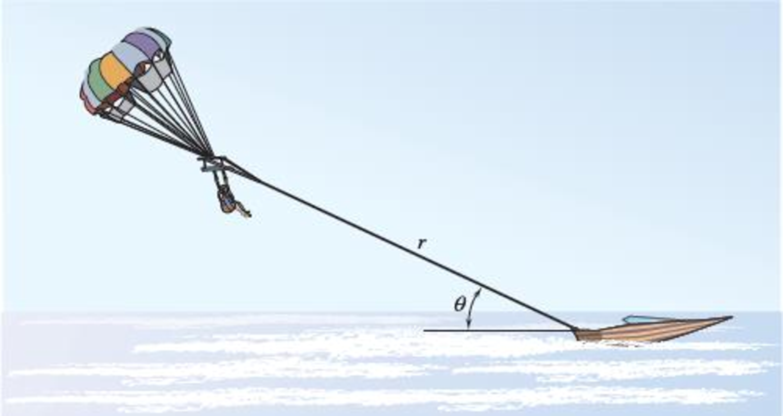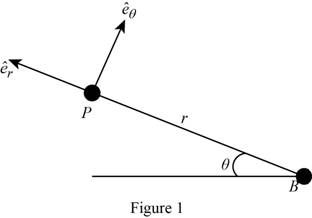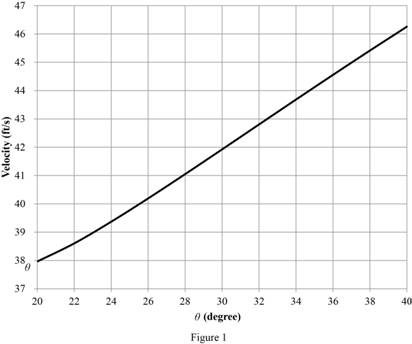
Concept explainers
Some parasailing systems use a winch to pull the rider back to the boat. During the interval when θ is between 20° and 40° (where t = 0 at θ = 20°), the angle increases at the constant rate of 2°/s. During this time, the length of the rope is defined by the relationship
Fig. P11.163 and P11.164

(a)
Plot the magnitude of the velocity of the parasailer as a function of time.
Explanation of Solution
Given Information:
During the interval the
The angle
The length of the rope is define by the relationship (r) of
The boat is travelling at a constant velocity
Calculation:
Convert the knot to feet per second.
Consider
Show the Free body diagram of parasailer and boat as in Figure (1).

Write the velocity
The acceleration vector of the boat is as follows:
Differentiate angle
Differentiate radius (r) with respective to time (t).
Differentiate
Write the expression for velocity vector
Here,
Write the expression for acceleration vector
Here,
Write the velocity vector
Write the acceleration vector
Write the velocity vector
Substitute
Calculate velocity vector of parasailer at an angle
Substitute 0 for t,
Here,
Calculate the velocity
Substitute
The time (t) is increase with 1 sec for an angle of
Similarly, calculate the velocity
Summarize the calculated values of velocity as in Table (1).
|
Time(t) (sec) | Radius (r) | |||||
| 0 | 20 | 600.000 | 0.000 | 32.463 | 19.681 | 37.963 |
| 1 | 22 | 599.875 | -0.313 | 33.434 | 19.298 | 38.603 |
| 2 | 24 | 599.293 | -0.884 | 34.616 | 18.751 | 39.369 |
| 3 | 26 | 598.051 | -1.624 | 35.911 | 18.051 | 40.193 |
| 4 | 28 | 596.000 | -2.500 | 37.274 | 17.195 | 41.050 |
| 5 | 30 | 593.012 | -3.494 | 38.676 | 16.180 | 41.924 |
| 6 | 32 | 588.977 | -4.593 | 40.090 | 15.001 | 42.804 |
| 7 | 34 | 583.795 | -5.788 | 41.494 | 13.658 | 43.684 |
| 8 | 36 | 577.373 | -7.071 | 42.867 | 12.149 | 44.555 |
| 9 | 38 | 569.625 | -8.438 | 44.190 | 10.474 | 45.415 |
| 10 | 40 | 560.472 | -9.882 | 45.446 | 8.635 | 46.259 |
Plot the magnitude of the velocity of the parasailer as a function of time as in Figure (1).

(a)
The magnitude of the acceleration
Answer to Problem 11.164P
The magnitude of the acceleration
Explanation of Solution
Given Information:
During the interval the
The angle
The length of the rope is define by the relationship (r) of
The boat is travelling at a constant velocity
Calculation:
Write the expression for acceleration vector
Substitute
Calculate the acceleration vector
Substitute 5 sec for t,
Here,
Calculate the acceleration
Substitute
Therefore, the magnitude of the acceleration
Want to see more full solutions like this?
Chapter 11 Solutions
Vector Mechanics for Engineers: Statics and Dynamics
- The primary material used in the production of glass products is silica sand. True or Falsearrow_forwardWhich one of the following is the most common polymer type in fiber-reinforced polymer composites? thermosets thermoplastics elastomers none of the abovearrow_forwardA pattern for a product is larger than the actual finished part. True or Falsearrow_forward
- Two forces are applied as shown to a hook support. The magnitude of P is 38 N. 50 N 25° DG a 터 Using trigonometry, determine the required angle a such that the resultant R of the two forces applied to the support will be horizontal. The value of a isarrow_forwardNo chatgpt pls will upvotearrow_forward101 the three shafts if the diameter ratio is 2 (D/d = 2)? Ans. na, tension = 1.21, na, bending = 1.19, na, torsion = 1.17. 6.32 A material with a yield strength of S₁ = 350 MPa is subjected to the stress state shown in Sketch c. What is the factor of safety based on the maximum shear stress and distortion energy theories? Ans. For MSST, n, = 11.67. 50 MPa 85 MPa 20 MPa 70 MPa Sketch c, for Problems 6.32 and 6.33arrow_forward
- Can you draw the left view of the first orthographic projectionarrow_forwardImportant: I've posted this question twice and received incorrect answers. I've clearly stated that I don't require AI-generated working out. I need a genuine, expert-written solution with proper working. If you can't provide that, refer this question to someone who can please!. Note: Please provide a clear, step-by-step handwritten solution (no AI involvement). I require an expert-level answer and will assess it based on quality and accuracy with that I'll give it a thumbs up or down!. Hence, refer to the provided image for clarity. Double-check everything for correctness before submitting. Thank you!arrow_forwardNote: Please provide a clear, step-by-step simplified handwritten working out (no explanations!), ensuring it is done without any AI involvement. I require an expert-level answer, and I will assess and rate based on the quality and accuracy of your work and refer to the provided image for more clarity. Make sure to double-check everything for correctness before submitting appreciate your time and effort!. Question:arrow_forward
 Elements Of ElectromagneticsMechanical EngineeringISBN:9780190698614Author:Sadiku, Matthew N. O.Publisher:Oxford University Press
Elements Of ElectromagneticsMechanical EngineeringISBN:9780190698614Author:Sadiku, Matthew N. O.Publisher:Oxford University Press Mechanics of Materials (10th Edition)Mechanical EngineeringISBN:9780134319650Author:Russell C. HibbelerPublisher:PEARSON
Mechanics of Materials (10th Edition)Mechanical EngineeringISBN:9780134319650Author:Russell C. HibbelerPublisher:PEARSON Thermodynamics: An Engineering ApproachMechanical EngineeringISBN:9781259822674Author:Yunus A. Cengel Dr., Michael A. BolesPublisher:McGraw-Hill Education
Thermodynamics: An Engineering ApproachMechanical EngineeringISBN:9781259822674Author:Yunus A. Cengel Dr., Michael A. BolesPublisher:McGraw-Hill Education Control Systems EngineeringMechanical EngineeringISBN:9781118170519Author:Norman S. NisePublisher:WILEY
Control Systems EngineeringMechanical EngineeringISBN:9781118170519Author:Norman S. NisePublisher:WILEY Mechanics of Materials (MindTap Course List)Mechanical EngineeringISBN:9781337093347Author:Barry J. Goodno, James M. GerePublisher:Cengage Learning
Mechanics of Materials (MindTap Course List)Mechanical EngineeringISBN:9781337093347Author:Barry J. Goodno, James M. GerePublisher:Cengage Learning Engineering Mechanics: StaticsMechanical EngineeringISBN:9781118807330Author:James L. Meriam, L. G. Kraige, J. N. BoltonPublisher:WILEY
Engineering Mechanics: StaticsMechanical EngineeringISBN:9781118807330Author:James L. Meriam, L. G. Kraige, J. N. BoltonPublisher:WILEY





